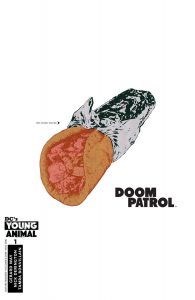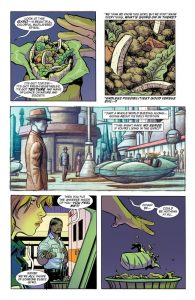Doom Patrol #1
 Author: Gerard Way
Author: Gerard Way
Artist: Nick Derington
Release Date: September 14, 2016
Publisher: DC Comics
★★★★★
To understand Doom Patrol #1, you have to understand the gyro analogy and that’s both true and as apt an analogy for the whole book as any you’re going to get.
The first issue of DC’s new imprint, Young Animal, isn’t an easy read and it’s far from an approachable debut but it’s one that rewards the deep dive. It’s a comic for the reader who wants to come back again and again, the reader who wants to follow the clues and connect the dots, figuring out the way things work by pressing buttons and pulling levers instead of reading an instruction manual. It’s a singular work of confidence and intent but one that makes no effort to play to readers who aren’t willing to play along right back.
Written by imprint editor and My Chemical Romance frontman Gerard Way with art by Nick Derington, Doom Patrol #1 is a character introduction of a sort by way of a mood piece. It’s a story focused primarily on Casey Brinke, a young paramedic who regularly encounters the strange and the unnerving to the point where she questions her own perception and reality, or is it?
Is Doom Patrol the story of Dr. Niles Cauler, an artist and physicist playing a song for no one, or is it? Maybe it’s the story of Ricardo and Danny the Street, a possibly telekinetic street who’s now been reduced to a pile of bricks, one of which was used to brain a mysterious, blue blooded figure. It might be about Robotman, a cybernetic freedom fighter who falls to earth before being hit by a truck.
There’s a lot happening in Doom Patrol #1 without a lot of explanation and it’s a book that demands readers, even longtime fans of the never-particularly-popular team, do some detective work to figure out. The stories and characters weave in and out of each others narratives in surprising, unconventional ways that only really connect on the second or third read through.
Doom Patrol #1 demands interaction from readers and it starts from the cover. In an homage to the iconic cover of the eponymous 1967 debut album of The Velvet Underground and Nico, the cover features a peel-away sticker of a gyro covering a drawing of a white hole. Just from that image, Doom Patrol #1 asks readers how far they’re willing to go and how much they’re ready to engage with a comic that’s not going to willingly offer many answers.
The issue hangs on that gyro though. Early on, Christie’s partner, enjoying an arcade-side snack, remarks on the “endless possibilities” within the limited space of the gyro or within the limited space of another person. It’s fundamentally a speech about possibilities, about the limitations of our perceptions versus what others are capable of but it casts a pall over the issue that’s hard to overcome. It forces us to ask questions of our narrator, of the character’s perception, and of the nature of the action itself.

Let’s take the gyro bit itself. As Sam throws away the gyro, our perspective zooms in deeper and deeper into the meat, before transitioning into a Laurence of Arabia style montage of Robotman sneaking and fighting his way into a fortress. The scene is inter-cut with a montage of a subway train and platform, an image that will recur later, but here’ it’s meant to keep the reader off balance.
We’re neither outright told that we’re inside the gyro or we’re somewhere else and the next page’s explosion both connects with Robotman’s press of the “Launch” button as well as links to the panel of his fall to Earth. It’s connected but it isn’t and the Robotman we see stumble out of an alley a few pages later isn’t the same Robotman we saw before. Of course, he’s transformed a third time when magic telegram-girl Terry None and Casey break his head open later.
Doom Patrol #1 forces readers to ask themselves these questions every few pages, digging through visuals, dialogue, and names for any reference that could point to some breakthrough. As such, it’s an issue that’s light on conventional plot or character elements. Doom Patrol #1 reads best as equal parts mood piece and puzzle box, as much Twin Peaks as True Detective. It’s a comic that feels like an experience, one that’s best enjoyed through discussion, theorizing, and interacting with.